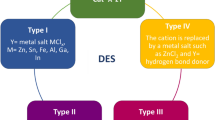Abstract
Enzyme catalysis with minimal ionic liquid quantities improves reaction rates, stereoselectivity and enables solvent-free processing. In particular the widely used lipases combine well with many ionic liquids. Demonstrated applications are racemate separation, esterification and glycerolysis. Minimal solvent processing is also an alternative to sluggish solvent-free catalysis. The method allows simplified down-stream processing, as only traces of ionic liquids have to be removed.















Similar content being viewed by others
References
Buncel E, Rajagopal S (1990) Sovatochronism and solvent polarity scales. Acc Chem Res 23:226–231
Dominguez de Maria P (2008) “Nonsolvent” applications of ionic liquids in biotransformations and organocatalysis. Angew Chem Int Ed 47:2–10
Ferrer B, Garcia H, Schultz KP, Nelsen SF (2007) Mixed valence compounds as probes to determine the polarity of 1-butyl-3-methylimidazolium ionic liquids. J Phys Chem B 111:13967–13970
Gathergood N, Garcia MT, Scammells PJ (2004) Biodegradable ionic liquids: part I. Concept, preliminary targets and evaluation. Green Chem 6:166–175
Guo Z, Xu X (2005) New opportunity for enzymatic modification of fats and oils with industrial potentials. Org Biomol Chem 3:2615–2619
Habulin M, Sabeder S, Paljevac M, Knez Z (2007) Lipase-catalyzed esterification of citronellol with lauric acid in supercritical carbon dioxide/co-solvent media. J Supercrit Fluids 43:199–203
Han X, Armstrong DW (2007) Ionic liquids in separations. Acc Chem Res 40:1079–1086
Heinsman NWJT, Schroën CGPH, Van Der Padt A, Franssen MCR, Boom FM, van’t Riet K (2003) Substrate sorption into the polymer matrix of Novozyme 435 and its effect on the enantiomeric ratio determination. Tetrahedron Asymmetry 14:2699–2704
Itoh T, Han S, Matsushita Y, Hayase S (2004) Enhanced enantioselectivity and remarkable acceleration on the lipase-catalyzed transesterification using novel ionic liquids. Green Chem 6:437–439
Itoh T, Matsushita Y, Abe Y, Han S, Wada S, Hayase S, Kawatsura M, Takai S, Morimoto M, Hirose Y (2006) Increased enantioselectivity and remarkable acceleration of lipase-catalyzed transesterification by using an imidazolium PEG-alkyl sulfate ionic liquid. Chem Eur J 12:9228–9237
Kim M-J, Lee JK (2004) Enzymes coated with ionic liquids. US 2004/0087462 A1
Kragl U, Eckstein M, Kaftzik N (2002) Enzyme catalysis in ionic liquids. Curr Opin Biotechnol 13:565–571
Lau RM, Sorgdrager MJ, Carrea G, van Rantwijk F, Secundo F, Sheldon RA (2004) Dissolution of Candida antarctica lipase B in ionic liquids: effects on structure and activity. Green Chem 6:483–487
Lee JK, Kim M-J (2002) Ionic liquid-coated enzyme for biocatalysis in organic solvent. J Org Chem 67:6845–6847
Liese A, Seelbach K, Wandrey C (2006) Industrial biotransformations. Wiley-VCH, Weinheim
López-Martin I, Burello E, Davey PN, Seddon KR, Rothenberg G (2007) Anion and cation effects on imidazolium salt melting points: a descriptor modelling study. Chem Phys Chem 8:690–695
Lozano P, de Diego T, Iborra JL (2006) Immobilization of enzymes for use in ionic liquids. In: Guisan JM (ed) Immobilisation of enzymes and cells, 2nd edn. Methods in biotechnology, vol 22. Humana, Totowa, pp 257–268
Lozano P, De Diego T, Carrié D, Vaultier M, Iborra JL (2001) Over-stabilization of Candida antarctica lipase B by ionic liquids in ester synthesis. Biotechnol Lett 23:1529–1533
Lozano P, Piamtongkam R, Kohns K, De Diego T, Vaultier M, Iborra JL (2007) Ionic liquids improve citronellol ester synthesis catalyzed by immobilized Candida antarctica lipase B in solvent-free media. Green Chem 9:780–784
Lozano P (2010) Enzymes in neoteric solvents: from one-phase to multiphase systems. Green Chem 12:555–569
Moniruzzaman M, Kamiya N, Goto M (2010) Activation and stabilization of enzymes in ionic liquids. Org Biomol Chem 8:2887–2899
Mutschler J, Rausis T, Bourgeois J-M, Bastian C, Zufferey D, Mohrenz IV, Fischer F (2009) Ionic liquid-coated immobilized lipase for the synthesis of methylglucose fatty acid esters. Green Chem 11:1793–1800
Park S, Kazlauskas RJ (2003) Biocatalysis in ionic liquids—advantages beyond green technology. Curr Opin Biotechnol 14:432–437
Park S, Kazlauskas RJ (2001) Improved preparation and use of room temperature ionic liquids in lipase-catalyzed enantio- and regioselective acylations. J Org Chem 66:8395–8401
Poole FC (2004) Chromatographic and spectroscopic methods for the determination of solvent properties of room temperature ionic liquids. J Chromatogr A 1037:49–82
Reichardt C (2007) Solvents and solvent effects: an introduction. Org Process Res Dev 11:105–113
Reichardt C (2005) Polarity on ionic liquids determined empirically by means of solvatochromic pyridinium N-phenolate betaine dyes. Green Chem 7:339–351
Van Rantwijk F, Sheldon RA (2007) Biocatalysis in ionic liquids. Chem Rev 107:2757–2785
Ventura SPM, Gonçalves AMM, Gonçalves F, Coutinho JAP (2010) Assessing the toxicity on [C3mim][Tf2N] to aquatic organisms of different trophic levels. Aquat Toxicol 96:290–297
Wasserscheid P, Welton T (2002) Ionic liquids in synthesis. Wiley-VCH, Weinheim
Yang Z, Pan W (2005) Ionic liquids: green solvents for nonaqueous biocatalysis. Enzyme Microb Technol 37:19–28
Zhao H (2005) Effect of ions and other compatible solutes on enzyme activity, and its implication for biocatalysis using ionic liquids. J Mol Catal B Enzym 37:16–25
Zhao H (2010) Methods for stabilizing and activating enzymes in ionic liquids—a review. J Chem Technol Biotechnol 85:891–907
Acknowledgments
The work on ionic liquid coated lipases was possible through the support by RealTech, Project No: 18644.
Author information
Authors and Affiliations
Corresponding author
Rights and permissions
About this article
Cite this article
Fischer, F., Mutschler, J. & Zufferey, D. Enzyme catalysis with small ionic liquid quantities. J Ind Microbiol Biotechnol 38, 477–487 (2011). https://doi.org/10.1007/s10295-010-0908-1
Received:
Accepted:
Published:
Issue Date:
DOI: https://doi.org/10.1007/s10295-010-0908-1




